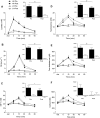Elevations in ostensibly anabolic hormones with resistance exercise enhance neither training-induced muscle hypertrophy nor strength of the elbow flexors
- PMID: 19910330
- PMCID: PMC2885075
- DOI: 10.1152/japplphysiol.01147.2009
Elevations in ostensibly anabolic hormones with resistance exercise enhance neither training-induced muscle hypertrophy nor strength of the elbow flexors
Abstract
The aim of our study was to determine whether resistance exercise-induced elevations in endogenous hormones enhance muscle strength and hypertrophy with training. Twelve healthy young men (21.8 +/- 1.2 yr, body mass index = 23.1 +/- 0.6 kg/m(2)) trained their elbow flexors independently for 15 wk on separate days and under different hormonal milieu. In one training condition, participants performed isolated arm curl exercise designed to maintain basal hormone concentrations (low hormone, LH); in the other training condition, participants performed identical arm exercise to the LH condition followed immediately by a high volume of leg resistance exercise to elicit a large increase in endogenous hormones (high hormone, HH). There was no elevation in serum growth hormone (GH), insulin-like growth factor (IGF-1), or testosterone after the LH protocol but significant (P < 0.001) elevations in these hormones immediately and 15 and 30 min after the HH protocol. The hormone responses elicited by each respective exercise protocol late in the training period were similar to the response elicited early in the training period, indicating that a divergent postexercise hormone response was maintained over the training period. Muscle cross-sectional area (CSA) increased by 12% in LH and 10% in HH (P < 0.001) with no difference between conditions (condition x training interaction, P = 0.25). Similarly, type I (P < 0.01) and type II (P < 0.001) muscle fiber CSA increased with training with no effect of hormone elevation in the HH condition. Strength increased in both arms, but the increase was not different between the LH and HH conditions. We conclude that exposure of loaded muscle to acute exercise-induced elevations in endogenous anabolic hormones enhances neither muscle hypertrophy nor strength with resistance training in young men.
Figures



Similar articles
-
Neither load nor systemic hormones determine resistance training-mediated hypertrophy or strength gains in resistance-trained young men.J Appl Physiol (1985). 2016 Jul 1;121(1):129-38. doi: 10.1152/japplphysiol.00154.2016. Epub 2016 May 12. J Appl Physiol (1985). 2016. PMID: 27174923 Free PMC article.
-
Resistance exercise-induced increases in putative anabolic hormones do not enhance muscle protein synthesis or intracellular signalling in young men.J Physiol. 2009 Nov 1;587(Pt 21):5239-47. doi: 10.1113/jphysiol.2009.177220. Epub 2009 Sep 7. J Physiol. 2009. PMID: 19736298 Free PMC article.
-
Physiological elevation of endogenous hormones results in superior strength training adaptation.Eur J Appl Physiol. 2011 Sep;111(9):2249-59. doi: 10.1007/s00421-011-1860-0. Epub 2011 Feb 16. Eur J Appl Physiol. 2011. PMID: 21327794 Clinical Trial.
-
Anabolic processes in human skeletal muscle: restoring the identities of growth hormone and testosterone.Phys Sportsmed. 2010 Oct;38(3):97-104. doi: 10.3810/psm.2010.10.1814. Phys Sportsmed. 2010. PMID: 20959702 Review.
-
Postexercise hypertrophic adaptations: a reexamination of the hormone hypothesis and its applicability to resistance training program design.J Strength Cond Res. 2013 Jun;27(6):1720-30. doi: 10.1519/JSC.0b013e31828ddd53. J Strength Cond Res. 2013. PMID: 23442269 Review.
Cited by
-
Neither load nor systemic hormones determine resistance training-mediated hypertrophy or strength gains in resistance-trained young men.J Appl Physiol (1985). 2016 Jul 1;121(1):129-38. doi: 10.1152/japplphysiol.00154.2016. Epub 2016 May 12. J Appl Physiol (1985). 2016. PMID: 27174923 Free PMC article.
-
Endocrine responses of the stress system to different types of exercise.Rev Endocr Metab Disord. 2023 Apr;24(2):251-266. doi: 10.1007/s11154-022-09758-1. Epub 2022 Oct 15. Rev Endocr Metab Disord. 2023. PMID: 36242699 Free PMC article. Review.
-
Temporal associations between individual changes in hormones, training motivation and physical performance in elite and non-elite trained men.Biol Sport. 2016 Sep;33(3):215-21. doi: 10.5604/20831862.1201810. Epub 2016 May 1. Biol Sport. 2016. PMID: 27601775 Free PMC article.
-
The Cross-Education Phenomenon: Brain and Beyond.Front Physiol. 2017 May 10;8:297. doi: 10.3389/fphys.2017.00297. eCollection 2017. Front Physiol. 2017. PMID: 28539892 Free PMC article.
-
Acute changes in serum and skeletal muscle steroids in resistance-trained men.Front Endocrinol (Lausanne). 2023 Apr 3;14:1081056. doi: 10.3389/fendo.2023.1081056. eCollection 2023. Front Endocrinol (Lausanne). 2023. PMID: 37077354 Free PMC article.
References
-
- Adams GR. Autocrine/paracrine IGF-I and skeletal muscle adaptation. J Appl Physiol 93: 1159–1167, 2002 - PubMed
-
- Baar K, Esser K. Phosphorylation of p70(S6k) correlates with increased skeletal muscle mass following resistance exercise. Am J Physiol Cell Physiol 276: C120–C127, 1999 - PubMed
-
- Bhasin S, Storer TW, Berman N, Callegari C, Clevenger B, Phillips J, Bunnell TJ, Tricker R, Shirazi A, Casaburi R. The effects of supraphysiologic doses of testosterone on muscle size and strength in normal men. N Engl J Med 335: 1–7, 1996 - PubMed
-
- Buresh R, Berg K, French J. The effect of resistive exercise rest interval on hormonal response, strength, and hypertrophy with training. J Strength Cond Res 23: 62–71, 2009 - PubMed
-
- Carroll TJ, Herbert RD, Munn J, Lee M, Gandevia SC. Contralateral effects of unilateral strength training: evidence and possible mechanisms. J Appl Physiol 101: 1514–1522, 2006 - PubMed
Publication types
MeSH terms
Substances
LinkOut - more resources
Full Text Sources
Medical
Miscellaneous

